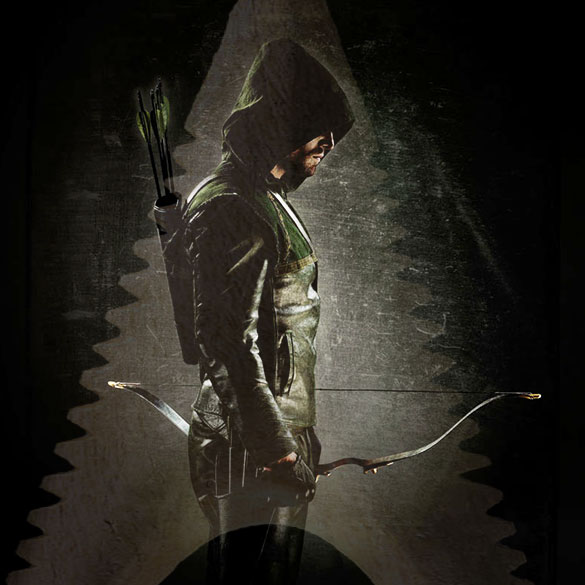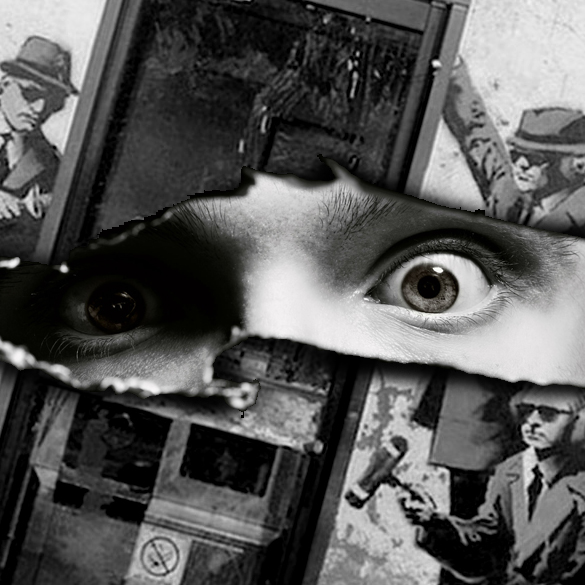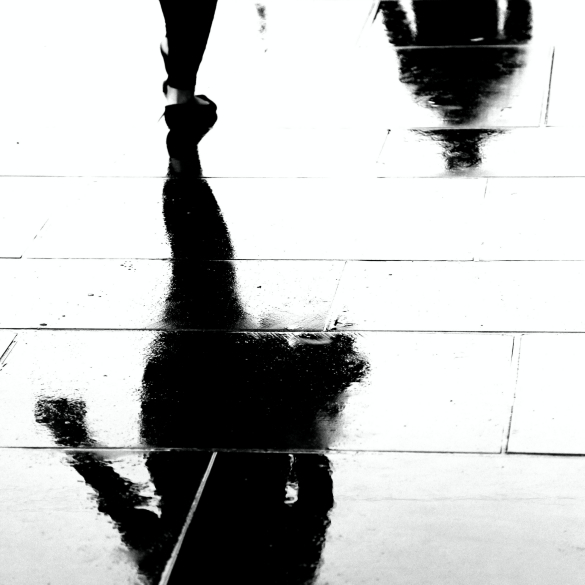You can’t look at the CW’s Arrow without coming across Stephen Amell’s abs. Just look at them. With Amell’s buttery skin, they’re a set of perfectly tanned marble mountains enough to make even a jaded viewer swoon. And he shows them off with a regularity that would make even Matthew McConaughey blush and, maybe, say “shucks.” But that’s just surface. The abs look great on a poster but there’s more to Arrow than a parade of near perfect flesh. Although indisputably eye candy for the CW’s demographics, Amell has taken to the small screen as DC Comics’ Green Arrow (Oliver Queen when he isn’t on the clock), a character more known for his leftwing politics and not his general hunkiness. But then, comic book characters adapted to TV and film are often off the mark.
Consider this, Amell’s character, never called Green Arrow on the show (that would be uncool) instead labeled as ‘The Hood,’ or ‘The Vigilante,’ kills with regularity. Near the end of Arrow’s first season, about several months in show time, his kill count is officially tagged at 26. Allowing the police of Starling City (another deviation from the comics) the benefit of a doubt that number still seems pretty low considering his fecundity placing arrow into chest cavity. But let’s backup. Green Arrow (who?) is a superhero. Don’t superheroes save lives, not take them?
For the most part, this is true. Yet, that is constrained to the printed page. Let’s take stock of the homicidal track record superheroes are saddled with when adapted to another medium. A superhero is either directly, or indirectly, responsible for the death of a main villain or henchmen in Superman II, Superman III, Batman: The Movie, Batman Returns, Batman Forever, X-Men, Spider-Man, Spider-Man III, Batman Begins, Iron Man, Dark Knight, Iron Man II, Thor, Captain America: The First Avenger, Dark Knight Rises, X-Men: First Class, Avengers, and Iron Man III. This list doesn’t even encompass comic book characters (not the same thing as superheroes) that are blatant killers, such as the Punisher, Wolverine, or Blade. Nevertheless, superheroes, by and large, have been transformed from their source material into a skewed representation.
The word hero derives, of course, from ancient Greek. It referred to individuals of exceptional martial prowess and unending courage. Yet, there was a caveat. The original definition stipulated that heroes were also those claiming divine parentage. Many cults developed around the worship of heroes, essentially demi-gods, such as Achilles, Hercules, and Perseus. These early heroes weren’t all that different from the superheroes of now, at least, in terms of physicality. Hercules could change the course of mighty rivers. So can Superman. Still, what defined them as heroes was largely due to their deeds on the battlefield and who their parents were. Zeus knocked up your mother as a shower of golden light. Congratulations! A hero is born!
Achilles slaughtered Trojans. That made him a hero. Theseus beheaded the Minotaur. Hooray! However, over time, the term hero began to take on a far more multifaceted meaning. Today, one doesn’t need to be a warrior to be a hero. With the decline of classical paganism, and certainly with the spread of humanistic disciplines during the Renaissance, heroes shifted from being paragons of war to upstanding moral figures. The strength of heroes was measured less by their muscles and sinews and more by their convictions and beliefs. Terms like sacrifice, honor, duty, selflessness, and compassion are more familiar. Heroes, in the Western tradition, are now more about encapsulating the impulse to not just see things as they are, but by how they should be. For superheroes this is at their core.
The question of ought is a pressing one, a question expressed again and again in comics. What is the impulse for the triumph of good over evil? The assured victory of a hero? The ability to make sense of a world where terms like ‘justice’ and ‘honesty’ are not naturally phenomena? Even something as simple as the wish fulfillment of flight or super speed? All of these speak to the obsession that things are not right in the moment but can be made better. In summation, the conflict between Arrow and its source material is how this desire of ought is ultimately arrived at.
Green Arrow, created in 1941, never figured prominently as a superhero until Denny O’Neil and Neil Adams’ spun the character into the short lived Green Lantern/Green Arrow. Previously, he was a bland, Batman-with-a-bow that never carried his own ongoing title. But a growing wave of social awareness was seeping into comics. Green Arrow was at the forefront of superheroes responding to the world in a more meaningful, relatable way. An illustrative example appears in 1970’s Green Lantern/Green Arrow #76. Green Lantern, a space cop-cum-superhero, is breaking up a beating given by disgruntled tenants to their slumlord. Being on the side of order, Green Lantern is ready to haul the wronged tenants off to jail. To his surprise, Green Arrow, dashingly made up in faux-Errol Flynn regalia, swoops in, frees the tenants, implies Green Lantern of being a racist, and lectures his fellow Justice League companion on the real source of crime: the corrupt slum lord who extorts underprivileged renters and turns them to desperation. And he did all this with an assortment of arrows, both trick and standard. Sure, it was parochial and didactic but also deliberately nonlethal.
He wasn’t a killer. He refused to. Although a hothead with a mean social justice streak, Green Arrow pulled his punches. But you can’t blame people for getting nervous when you carry a bow and arrows around. He was feared, no doubt about that. For all his potential lethality, Green Arrow relied on subduing his enemies, either with trick arrows (such as one with a boxing glove affixed to the tip) or shots that would only wound. But the threat of death was there. This is what a lot of people think of when they think of superheroes. Goofy gadgets. Gimmicks. A tendency to hold back despite overwhelming power. Letting the villain go to jail, only to escape later, and having the whole drama play out again.
Superheroes are thought of this way because, for the most part, they are ardent deontologists. Unlike utilitarians, who see the ends as justification for the means, deontologists are concerned exclusively with the means. Achieving one’s goal of a better world is lofty and noble but it depends on how you get there. After all, the road to hell is paved with good intentions. That’s why, historically, superheroes have refrained from killing. Sure, censorship in the 1950s codified this trait, but from that imposition something wonderful emerged. Green Arrow’s life would be immeasurably easier if he just loosed an arrow into Deathstroke or Merlyn’s forehead. But, he doesn’t. Why? Because that would be wrong, legally and ethically. Even if superheroes operate outside the law, they still hold themselves to a code that is strikingly similar.
While there are comic book examples of Green Arrow killing purposefully, deliberately, Mike Grell’s extended tenure with the character being an example, going down that route removes the super from superhero. Grell’s Green Arrow run visibly stripped away many of the superheroic elements in favor of a gritty noir/spy vibe filed with secret agents, drug dealers, and a very 80s Seattle. At no point did it pretend it was something it wasn’t. Costumes were faced out. Secret identities went away. The book stopped being a superhero comic, consciously. But it still understood what had propelled superheroes for decades.
The agony of taking lives is even expressed in Grell’s Green Arrow: The Longbow Hunters #3 from 1987. Oliver Queen is on the trail of Shado, a slighted Yakuza assassin with a bow. As the two team up to put a stop to an Iran-Contra esque scandal, Shado expresses her desire to kill the guilty parties:
GREEN ARROW: You think I’ll stand by and watch you kill a man in cold blood?
SHADO: I watched you. Those men who were torturing your woman…could you not have stopped them without killing them?
Queen’s reaction, illustrated by Grell, is easy enough to read. He’s troubled. His eyes are vacant. It is the look of a character that knows he has crossed a line and is not comfortable with the path he is undertaking. He is a deontologist that has failed to live up to his principles. Tellingly, in O’Neil and Adams’ Green Lantern/Green Arrow, Green Arrow accidently misfires and kills a thug, he rejects his mantle and retreats into a monastery. He becomes so consumed with guilt that he shaves his head and would rather live his days out in exile than go forward as tainted goods. Contrast that with Amell’s Green Arrow on TV.
In the first episode, he enters a building intent on bringing a corrupt businessman to task. The goal is to redistribute millions of dollars to the wronged and underprivileged of Starling City through some computer tomfoolery. The mission is a clear link to superhero Green Arrow’s wheelhouse, him being a modern analog of Robin Hood, after all. But, along the way, his tactics diverge. Instead of keeping his eyes squarely on his target, he goes ahead and porcupines almost a dozen henchmen. Judging through the narrow window of my TV, at least several goons are skewed mortally. You don’t walk away from getting shot dead center in the chest. Not only does Amell’s Arrow seem unperturbed by this but he does it again and again in subsequent episodes. He’s cold, calculating, and even if you factor in the debatably worthwhile project of executing corrupt businessmen and gangsters, he still slaughters any security guard that just happens to be on shift.
And he’s not living in some strange parallel universe where this isn’t problematic. The entire supporting cast (hats off to the wonderful David Ramsey as Dig) calls him out on his homicidal tendencies. I’m sure the word ‘murderer’ is used more than once to describe the show’s protagonist who barely bats an eye at the charge. The ends justify his means, after all. Can’t make an omelet without breaking a few eggs or, in Arrow’s case, offing those that stand in his way on his mission of personal vengeance against corrupt elites. This is pure utilitarianism flying in the face of Oliver Queen’s deontological roots.
This divergence manifests again and again in superhero adaptations. The source is that so many producers and writers are so familiar with the narrative conventions of Hollywood action films that they cannot embrace the deontological roots of what they’re adapting. Think of it this way, the deontological refusal to kill is absolutely geared towards serialization. Engaging with moral dilemmas again and again is what superhero comics can do very well because these stories are not designed to end. ‘To be continued…’ is what defines superheroes. As Grant Morrison keenly notes: Superman was having adventures before he [Morrison] was born and will continue to do so long after he’s dead. Even when comic books try to run with a utilitarian superhero, such as the Punisher, the series quickly writes itself into a corner as solution after solution collapses any sense of a prolonged narrative. When you can just kill your way out of a problem the corpses become an albatross.
Shows like Arrow cannot abide by the constant continuation of narrative. The same is even more apparent for Hollywood blockbusters. It just isn’t feasible for the actors or financers to carry on as comic books do. Audiences, too, wouldn’t stand for it. The end result is a reliance on utilitarian solutions that transform superheroes into simple action heroes. Arrow’s season finale starkly renders this:
Malcolm Merlyn (John Barrowman) a wealthy powerbroker with archery skills rivaling Oliver Queen’s, has planted a device underneath the worse neighborhood in Starling City that will destroy, in his mind, the source of crime that has, prior to the show, robbed him of his wife. Queen attempts to stop this plot by killing his foe. After delivering the fatal shot (and with a supporting character risking his life to stop the device) Queen is informed that a second device is about to go off, rendering his lethal victory hollow. The neighborhood, AKA The Glades, is wracked with violent earthquakes and crumbles. It’s an interesting narrative arc whereby the villain is killed, thereby failing, but also wins by having his plan succeed.
Utilitarian solutions are sexy, concrete, and final. That’s part of the appeal super villains and antiheroes. Their solutions, no matter how grandiose or reprehensible, are fitting ends to a narrative arc. They end things, decisively, without compromise. Deactivating the device with Merlyn in handcuffs would have been an unfitting denouement on a network known for its melodramatic excesses. The same goes for a twenty-two episode season of a costumed adventurer taking out villains in a nonlethal way while exploring the roots of social ills. Wrestling with moral dilemmas has largely disappeared from network television and Hollywood. Just look at how Star Trek, once a slow, cerebral show concerned with morality, ethics, and human exploration has turned into a film series filled with action scenes that might have a story linking it all together.
So calling Arrow a show about a superhero is incorrect. Calling many of the box office giants superhero movies is also incorrect. They’re action movies, plain and simple. They utilize comic books for inspiration. Make no mistake, superhero and comic book are not synonymous terms. One is a genre and the other is a medium. That’s not to say that Arrow and, by extension, comic book movies from the past several decades are failures. As a TV show, it needs to be judged on what it set out to accomplish, entertain the CW’s core audience. But, as an accurate representation of what elevate superheroes, it is inaccurate. The characters have more in common with John Rambo and John McClane than with Oliver Queen.
Call them heroes but certainly don’t think of them as superheroes. The abs might be spot on (and, in Amell’s case, aren’t they ever?) but the substance underneath the skin is off kilter.
—
James Orbesen is a writer and adjunct living in Chicago. His writing has appeared in Salon, Midwestern Gothic, Jacobin, The New Humanism, Bookslut, The Collagist, 215 Ink’s Ignition anthology and elsewhere. Work is forthcoming in TriQuarterly and the Cosmic Outlaws anthology.




Great article. I love watching Arrow, but I think maybe the new Batman movies are the closest to the comic books. And can we please stop making Superman movies, and now they want to make Superman vs Batman!